One
Great Year Archive – II
This
feature discusses a season in which a team finished much higher than they
did in the immediate past or future or a player far surpassed any other
year of his career.
1912: Chief Wilson
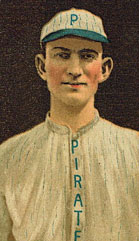
Chief Wilson
|
John Owen "Chief" Wilson joined the Pittsburgh Pirates in 1908 at the age of 24.
- He held down RF for the Pirates through 1913 before being traded to the St. Louis Cardinals, for whom he played his last three big league seasons.
- His batting average rose every year from 1908-1912: .227, .272, .276, .300, .300.
- He led the NL in RBIs in 1911 with 107.
But Wilson is remembered for one astounding statistic: he hit 36 triples in 1912, a record that still stands.
- No one since has come within 10 of his astounding feat - Sam Crawford belted 26 three-baggers in 1914 as did Kiki Cuyler in '25. Shoeless Joe Jackson had set the AL record when he whacked 26 in 1912.
- 19th century players hold places two through eight in the list of most triples in a season. But the best of them could manage only 31 (Dave Orr in 1886 and Heinie Reitz in '94).
- Wilson's mark also holds for all of organized baseball since no minor leaguer has ever hit more than 32 triples in a season.
- In addition, Chief tied a major league record when he hit three triples in a game. He didn't do this in his record season of 1912 but rather on July 24, 1911.
- He hit two triples in a game four times in 1912, three of the feats occurring in his home park and the other in Cincinnati.
|

Forbes Field opener in 1909
How do we account for Wilson's fabulous year considering he never hit more than 14 triples in any other campaign?
- One factor was the park he played in. Forbes Field, which opened in 1909, showed these dimensions in 1912: LF 360', LCF 462', CF 409', RCF 375', RF 376'. Barney Dreyfuss, the Pittsburgh owner, "hated cheap home runs and vowed he'd have none in his park."
- Owen hit 24 of his 36 three-baggers in that park. He also led the next highest Pirate, Honus Wagner, by 16. 31 of Wilson's 59 career HRs were inside-the-park.
- Chief's predilection for triples caught the imagination of the fans, who expected to see one every time he came to bat. According to the Pittsburgh Post (9/14/1912): Wilson attemped to triple but tapped the pellet a trifle too hard and floated it over the right field wall.
- Opponents tried shifts to stop him but saw the ball fly over their heads or to the opposite field.
- Wilson's speed also made him an excellent outfielder who could cover the broad expanses of Forbes Field. He twice led NL outfielders in fielding percentage and in 1914 recorded a league-leading 34 outfield assists.
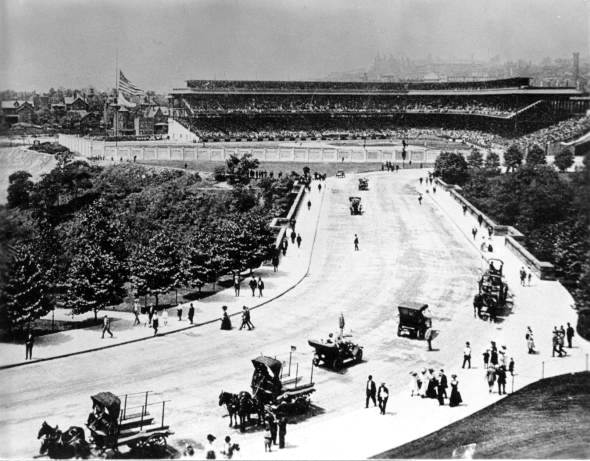
Forbes Field in 1909 References: " Chief Wilson," Baseball: The Biographical Encyclopedia (2000)
"36 Triples by Chief Wilson in a Single Season," baseball-almanac.com
Top of Page
1918: Scott Perry, Philadelphia A's

Scott Perry
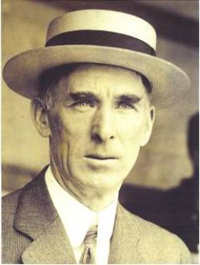
Connie Mack
|
RHP Scott Perry had one outstanding year for the Philadelphia Athletics in 1918. Yet it took a court injunction setting aside a ruling of for Connie Mack's A's because of a controversy that was resolved by the National Commission, baseball's ruling body at the time, and which led to the resignation of National League President John Tener.
Perry pitched briefly in the majors each season from 1915-1917, appearing in a total of nine games.
- In May 1917, the Boston Braves purchased his contract from the Atlanta Crackers of the Southern Association for a $500 down payment, with $2000 more to be paid if the Braves kept him.
- However, after not pitching in even one game after 17 days, Perry jumped the Braves and joined an independent team.
- The National Commission, which consisted of the president of the NL (Tener), the president of the AL, Ban Johnson, and August Herrmann, the president of the Cincinnati Reds, ruled that, if Perry returned to organized baseball, he would be the property of Atlanta unless the Braves paid the remaining $2000.
Perry rejoined the Crackers who sold him again, this time to the A's in April 1918.
- When Scott started winning games for the Mackmen, the Braves decided to exercise their claim on the hurler.
- The National Commission, augmented by the secretary of the National Association and the president of the Southern Association because the dispute involved both major leagues and a minor league, voted 3-2 to award Perry to Boston.
- Mack strongly protested the ruling and refused the Braves' offer to accept another A's player in place of Perry.
- Instead, with at least the tacit permission of Johnson, Connie secured a civil court injunction preventing the Braves from getting Perry.
|
None of this off-field wrangling bothered Scott who won 21 games while losing 19 for the last place A's.
- He led the AL in innings (332 1/3), starts (36), and complete games (30 to tie with Carl Mays of the Red Sox).
- His ERA was a splendid 1.98, which ranked fourth.
The NL owners fumed over Mack's lawsuit, the first to violate the gentlemen's agreement that "what happens in baseball, stays in baseball."
- Tener refused to sit on the National Commission again and even recommended cancelling the World Series unless Mack ceded Perry to the Braves.
- Already on shaky ground with his owners, Tener resigned when they refused to back him fully on this issue.
- Eventually, a compromise was reached whereby the A's kept Perry but withdrew the injunction and paid the Braves $2500 as compensation for his services.
The rest of Perry's career comes under the heading "be careful what you wish for."
- In 1919, his ERA rose to 3.58 and he won only 4 while losing 17.
- The next season, he was 11-25/3.62.
- In 1921, he appeared in only 12 games with a 3-6 mark and 4.11 ERA.
- His career mark was 40-68 with a 3.07 ERA.
All in all, he was hardly a talent that merited the fuss created around him in 1918.
|
1924: "Sloppy" Thurston, Chicago White Sox
Hollis "Sloppy" Thurston was born in 1899 in Fremont NE.
- The 5'11" 165 lb RHP made his ML debut in 1923 with the St. Louis Browns. He was quickly traded to the Chicago White Sox, for whom he toiled the rest of that season and three more.
- His rookie season was non-descript: 7-8 record in 44G, 12 GS, 8 CG, 4 Saves, ERA 6.75.
- He did have one shining moment. On August 22, 1923, he struck out three batters on nine pitches in the 12th inning of a 3-2 loss against the Philadelphia Athletics. He became the second AL pitcher and the sixth pitcher in MLB to achieve an "immaculate inning." He is also the only P ever to achieve the feat in an extra inning.
|
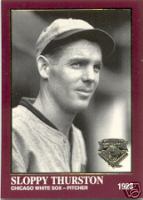 |
Thurston hit the jackpot in 1924 for the last place White Sox (still reeling from the Black Sox controversy that resulted in most of their key players being banned from baseball).
20-14 in 38 G, 36 GS, 28 CG, 1 SV, ERA 3.05 in 291 IP
He reeled off 10 straight victories before the Yankees beat him on July 29. His 28 CG led the league.
As you would expect since the title of this feature is "One Great Year," he dropped off sharply in subsequent seasons.
- 1925: 10-14 in 36 G, 25 GS, only 9 CG, 1 SV, 183 IP, ERA 5.95
- 1926: 6-8 in 31 G, 13 GS, 6 CG, 3 SV, 134.3 IP, ERA 5.02
- 1927: Traded to the Washington Senators because Sox manager Eddie Collins declared Sloppy's arm dead, he went 13-13 in 29 G, 13 CG, 205.3 IP, ERA 4.47.
He did not return to the majors until 1930 with Brooklyn, for whom he pitched four years.
- He compiled a 33-29 record with the Dodgers.
- 3.40 in 1930 was his lowest ERA.
- He managed another distinction while with Brooklyn, this one dubious. On August 13, 1932, he allowed six HR in the first game of a DH to tie the post-1900 ML record.
His career stats were: 89-86 in 277 G, 178 GS, 4.24 ERA.
- He is considered one of the best-hitting pitchers of all time, with a .270 lifetime average and four .300 seasons. In fact, he often played 1B in the minor leagues when not hurling.
- After retiring, he became a longtime scout. His chief claim to fame in that career is signing Ralph Kiner for the Pirates.
If you're wondering about Sloppy's nickname, he inherited it from his father, a restaurant owner who served free soup to the poor. (He "slopped" the soup in the bowls. Get it?) Hollis was actually a meticulous dresser in the Jazz Age.
|
1950: Johnny Groth, Detroit Tigers
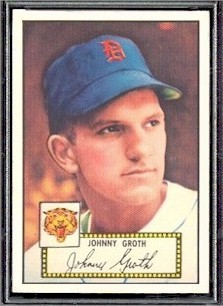 |
In spring training before his rookie year of 1949, veteran players labeled Johnny Groth of the Detroit Tigers as "can't miss."
- Even his manager, Red Rolfe, put pressure on him. "I took one look at him and decided instantly. He may develop into a hell of a ballplayer."
- His right-handed batting reminded some sportswriters of Joe "Ducky" Medwick in his heyday with the St. Louis Cardinals.
Yet Groth did not always seem destined for baseball stardom. In fact, it took World War II to divert him from football.
- As a triple-threat halfback at Chicago Latin School, he never spent much time on baseball.
- However, before he decided which college scholarship to accept, the Navy grabbed him and sent him to the Great Lakes Naval Training Station.
- In the "physical education" program, he played baseball seriously under the watchful eyes of Cleveland's Bob Feller and Detroit's Pinky Higgins.
- When the 19-year old was discharged from the Navy in 1946, he couldn't pass up a $30,000 bonus to sign with the Tigers.
He rose through the ranks quickly.
- After a year at Williamsport PA, he moved to Buffalo of the AAA International League, where he played CF artfully with a strong arm, hit .340 and clouted 30 HRs.
- Called up to the parent club near the end of the season, he hit the first pitch he saw 340 feet into the stands at Briggs Stadium.
- No wonder some pegged him as "the next DiMaggio." When Joe himself was asked to rate him after a spring training game, he tactfully reserved judgment.
|
Did he live up to his promise?
- 1949: Johnny didn't disappoint his rookie year. He finished fourth in the AL Rookie of the Year balloting (Roy Sievers of the St. Louis Browns won), primarily because he played only 103 games because of injuries. .293 BA, 73 RBI, and 11 HR in 2/3 of a season were impressive. The same speed that made him an excellent RB enabled him to cover the cavernous CF at Briggs Stadium.
- 1950: He lived up to the hype.
157 G, 95 R, 173 H, 12 HR, 85 RBI, .306
At one point, he had eight straight hits. Little did anyone know at the time, but these would be his career highs in each of those six categories.
- 1951: 118 G, 41 R, 128 H, 4 HR, 51 RBI, .299
- 1952: 141 G, 56 R, 149 H, 3 HR, 57 RBI, .284
Before the 1953 season, the Tigers traded Groth to the Browns as part of a six-player deal.
- After one season in St. Louis, he went to the White Sox, then Washington and Kansas City briefly, then back to Detroit for the final 3+ seasons of his career.
- His major problem was that he lacked power, which most clubs demanded from their OF. Johnny hit only 60 HR in 1,248 ML games.
He is often compared to another contemporary CF, Jimmy Piersall, in terms of all-around ability. Good hitter (.279 career average), above-average fielder, but certainly not another DiMaggio – at least not Joe but maybe Dom.
|

Johnny Kucks
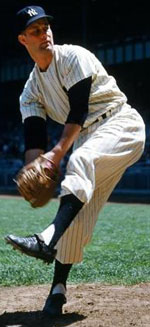
Bob Grim
|
1956: Johnny Kucks, New York Yankees
Johnny Kucks won 42 games for the Yankees from 1955-59. 43% of those victories came in 1956.
- Born in Hoboken NJ, Kucks grew up in Jersey City, just across the Hudson River from New York City.
- After compiling a 19-6 record at Norfolk of the Piedmont League in 1952, the 19-year-old hurler spent the next two seasons in the military.
- After a stint at the Yankees' instructional school, Kucks joined the Yankees for spring training in 1955. He threw a fast ball and sinker with professional control.
- Johnny's roommate was P Bob Grim, the AL Rookie of the Year in 1954 after two years of military service.
- Amazingly, Kucks made the Yankee roster and went 8-7 in 29 games, including 13 starts. He pitched three innings in the World Series, which the Dodgers won in seven.
Those statistics did not prepare the American League for what Kucks did in 1956.
- Peter Golenbock: In the spring of 1956 Kucks continued to be outstanding, throwing with a loose-jointed, easy three-quarter motion, imparting a heavy over-spin on the ball that caused batters to break their bats and sting their hands if they didn't meet the ball just right. The fielders enjoyed playing behind Kucks because he pitched quickly.
- Part of the starting rotation from the beginning of the season, Kucks won 18 and lost only 9. He twirled 12 complete games and finished with a 3.56 ERA. Only Whitey Ford (19-6) tallied more victories.
- The Yankees won the pennant by 9 games over Cleveland.
The 1956 World Series is remembered for Don Larsen's perfect game, but Kucks was also a hero.
- Johnny appeared in relief in the first two games at Ebbets Field, both Brooklyn victories.
- For the third straight time, a Dodger-Yankee Series went to the seventh game.
- Casey Stengel chose Kucks, who responded with a three-hit shutout as the Yanks romped 9-0. His sinker working, Johnny allowed only two fly balls all afternoon.
The momentum from the Series finale didn't carry over to 1957 for Kucks.
- He started 23 games but finished only 10. His final tally showed only 8 wins against 10 losses.
- Ironically, his ERA actually dropped to 3.56.
- He pitched only 2/3 of an inning in the '57 Fall Classic.
Kucks stayed stuck on eight for the rest of his career.
- He won only 8 again in '58, leading to his trade to the Kansas City Athletics early in the '59 campaign.
- He contributed eight victories to the A's in '59 but dropped to just 4-10 with a 6.00 ERA in '60.
- After three years in the minors with no call back to the majors, Johnny retired after the '63 season.
Reference: " Dynasty: The New York Yankees 1949-1964, Peter Golenbock (1975)
Top of Page |
1957: Von McDaniel, St. Louis Cardinals
One of the strangest careers in MLB (and, to Cardinal fans like me, one of the most painful) is that of Von McDaniel. He roared across the baseball firmament like a meteor for one half season and then fell to earth with a thud. A St. Louis pitcher of the current century has been compared to him.
- Max Von McDaniel was born in 1939 in Hollis OK.
- The Cardinals signed him in May 1957 as a "bonus baby," which meant that he had to be placed on the ML roster, where he joined his brother Lindy, the Cards' ace reliever in his third season in St. Louis.
|
Lindy McDaniel puts a hat on his 18-year old brother Von after he signed with the Cardinals. |
Von proved to be a "natural" who threw an exploding fastball and a sharp curve with a smooth, effortless delivery.
- He won his first four starts and at one point pitched 19 straight scoreless innings. This streak included a one-hitter, a two-hitter, and a perfect game for six innings.
- On August 3, he outdueled Robin Roberts of the Phillies, 3-2, to give St. Louis a game-and-a-half lead over the Milwaukee Braves.
- That proved to be the Cardinals' high point as they finished 8 games behind the Braves.
- Von fashioned a 3.22 ERA in 86 2/3 innings. He started 13 games and finished 7-5. He struck out 45 and walked 31.
Cardinal fans had every reason to believe Von would be a solid starter for years to come. However, during the offseason, something strange happened. Von McDaniel forgot how to pitch.
- Lindy recalls what happened when his brother came to spring training in 1958.
He lost his coordination and his mechanics. There was no real explanation. Some people thought it was psychological. But who knew about those things then?
- Even though he was terrible in the Grapefruit League, he pitched two games for St. Louis in the regular season. He walked five and struck out none in two innings, yielding three runs.
- The Cardinals sent him to the minors in hopes he would find his rhythm again.
Von fell all the way to Class D before he finally threw smoothly again.
- A 13-5 record in the Florida State League earned an invitation to the Cardinals' camp for 1961.
- However, under pressure again, he lost his "magic touch" and was soon out of baseball.
Von's story was reprised in 2000 when another Cardinal phenom, Rick Ankiel, suddenly lost control.
- Rick's meltdown occurred in the playoffs rather than spring training.
- And Ankiel's story has a happier ending since he came back to the majors as an outfielder.
|
1962: Kenny Hubbs, Chicago Cubs
In the bleak era of the 1950s and early 1960s, Kenny Hubbs was a ray of hope for Cubs fans. Born 16 days after Pearl Harbor, Hubbs earned NL Rookie of the Year in 1962 with these stats.
- Games: 160
- Batting average .260
- Runs: 90
- RBI: 49
Manning 2B that season, he became the first rookie to win a Gold Glove, an award that had been inaugurated only in 1957. The Cubs finished ninth, behind even the expansion Houston Colt 45s.
Even though he slumped to .235/54/47 in 1963, "Hubbs of the Cubs" was projected to be a fixture at 2B for years to come. However, he never played another ML game.
| 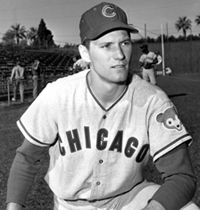
Kenny Hubbs |
- As a way to overcome his fear of flying, Kenny took flying lessons and obtained his license.
- Two weeks later, he flew with his friend Dennis Doyle to Provo UT to visit Doyle's parents.
- Raised a Mormon, Hubbs participated in a charity basketball game for the Church of Jesus Christ of Latter Day Saints. Then the pair headed back to their hometown of Colton CA.
- However, one minute into their flight in extremely cold February weather (-1 F) and heavy snow, the plane crashed. The bodies were found two days later.
- Cub teammates Ron Santo, Ernie Banks, Glen Hobbie, and Don Elston were pallbearers at Hubbs' funeral in Colton.
The club kept Kenny's #16 out of circulation for several years before issuing it again.
- Glenn Beckert took over 2B from 1965-1973.
- Then, in the 80s, another Mormon played the position as no Cub ever had – Ryne Sandberg.
|
Mark Fidrych took the baseball world by storm in 1976. Not only did he win 19 games for the Detroit Tigers as a rookie but also delighted the fans home and away with his off-beat antics.
Here's how Franz Lidz recalled the story in a Sports Illustrated article in 2001.
A quarter century ago a pitcher named Mark Fidrych made a name for himself — the Bird — with his oddball exuberance. The rube-ish rookie packed 'em into Tiger Stadium by sprinting to his position, landscaping the mound with his hands and talking to the baseball, like some hardball Hamlet addressing Yorick's skull. A flake, they called him, the game's most refreshing character since Dizzy Dean. The truth is, Bird was less kook than canny clown. He became a merchandising sensation, attaching his image to everything from T-shirts to 45-rpm records.
The native of Worcester MA easily won Rookie of the Year and finished second to Jim Palmer for the Cy Young Award in the AL with these statistics.
19-9, 2.34 ERA, 24 CG in 29 starts, 250.3 IP
He soared to national acclaim after he started against the Yankees on June 28 on ABC's Monday Night Baseball.
- With a 90 mph sinking fastball and hard slider, Mark won 5-1 before 50,000.
- When the game ended, his teammates pushed him back out of the dugout to take a curtain call as the crowd yelled "Bird! Bird!"
- "That's when it all took off," Mark recalled,
Mark's innocence was illustrated by an exchange with reporters after the game.
- Thurman Munson, the Yankees C who sat out the game, had called Fidrych "fly-by-night" and "a showboat."
- When asked about Munson's remark, Mark asked, "Who's Thurman Munson?"
- The reporters rushed out to send that comment to their papers and wire services. They took it as trash talking, not realizing that Mark was serious.
|
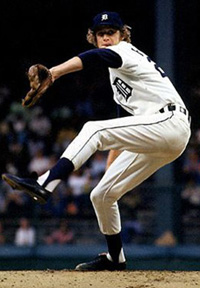
Mark Fidrych
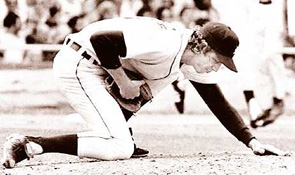
|
Unfortunately, the Bird tore cartilage in his knee late in spring training of 1977.
- When he finally made his first start 51 days into the season, 44,207 turned out in "musty old Tiger Stadium." Fidrych pitched nine strong innings but lost to the expansion Seattle Mariners 2-1.
- "He's so young and eager," said Tiger manager Ralph Houk. "But we wanted to bring him back slowly, so that the first time he started, he'd be ready to go nine."
- Since Fidrych had drawn an average of 18,268 extra fans every time he started in 1976, the Tigers front office estimated that the six home starts Mark had missed cost the club a half-million bucks in gate receipts.
Then in a game in Baltimore a few weeks later, he tore the rotator cuff in his right shoulder.
- He never fully recovered from that injury.
- As a result, he won only ten more games in the majors after his magical 1976 season.
- 1980 was his last season with Detroit.
Yet, many people have never forgotten the Bird.
- In 2001, he still received fan mail every day and made $15-20,000 a year for appearing at store openings, baseball card signings, and minor league games.
- Young kids who heard their dads talk about him requested autographs for Father's Day.
Sadly, Mark died in an accident at his farm on April 13, 2009 at age 54.
|
1985: Danny Cox, St. Louis Cardinals
Danny Cox first pitched for the St. Louis Cardinals in 1983.
- The 6'4" 235 lb righty from Troy State University started 12 games for a 3-6 record.
- He then stayed with the Redbirds and had a so-so 1984 in the starting rotation: 9-11 4.03 ERA.
Despite his size, Cox possessed only an average fastball.
- Instead, he relied heavily on a great change-up.
- He broke out in 1985, providing a key boost to the Cardinals' pennant winning squad as the #3 starter behind 20-game winners John Tudor and Joaquin Andujar.
- His stats for '85 were:
18-9, 2.88 ERA, 10 CG in 35 starts, 241 IP
|
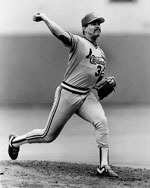
|
Cox started the third game of the NLCS against the Los Angeles Dodgers, a key 4-2 victory when the Cardinals were down 0-2.
- Then he toed the slab in the second game of the World Series against the Kansas City Royals. He left after seven down 0-2 but St. Louis rallied for 4 in the ninth to take a 2-0 Series lead.
- Danny pitched seven scoreless innings in the infamous "Don Denkinger Game" (Game 6) that the Cardinals lost in the bottom of the ninth, 2-1, a key factor in the Royals' becoming the first team to win the World Series after falling behind three games-to-one.
After 1985, Cox developed physical problems.
- He spent stretches on the disabled list in 1986, '87, most of 1988, and all of 1989 with bone chips, a broken foot, and tendinitis.
- His victories dropped from 12 to 11 to 3 to 0.
- He did start two games in the 1987 NLCS against the San Francisco Giants, losing Game 4 but twirling a shutout in Game 7.
- In the Fall Classic against the Minnesota Twins, he was pounded for 7 runs in 3 2/3 innings in Game 2, then lost Game 7 in relief.
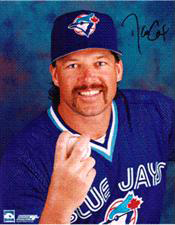 |
He returned to the majors with Philadelphia in 1991, compiling a 4-6 record in 17 starts.
- Released by the Phillies in June, 1992, he signed with the Pirates and pitched 1 1/3 innings in relief in the NLCS against Atlanta.
- Cox finished his career as a bullpen mainstay for the Toronto Blue Jays, tossing five scoreless innings in the 1993 ALCS and pitching in his third World Series that October.
After pitching only 18 2/3 innings in 1994 and 45 in 1995 for Toronto, Cox retired, having never come close to duplicating his outstanding 1985 season.
|
|
1989: Jerome Walton, Chicago Cubs
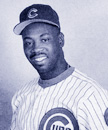 |
The
1989 NL Rookie of the Year was CF Jerome Walton
of the Chicago Cubs. He also finished
13th in the MVP voting. Batting mostly leadoff, he compiled
these statistics in only 116 games.
BA
.293, OBP .335, R 64, RBI 46, SB 24
With
a 30-game hitting streak during the season, Walton
helped spark the Cubs to the NL East
pennant, although they lost to the Giants
in the NLCS.
|
Since
Jerome was only 23, the Cubs
thought they'd be set in CF and the leadoff spot for years
to come. However, he never recaptured his rookie
magic.
- In 1990 he played in only 101 games because
of a broken hand and a wrist injury, hitting .263 and scoring
63 R but driving in only 21.
- The next year he dropped to .219 with only 42 R and
17 RBI.
- In 1993, after hitting only .127 in 30 games, Walton was sent to the minors.
- He signed with California in the off-season, but they quickly released him.
- He next
played for Cincinnati.
He wasn't bad for the Reds in '95: 102 G, .290, 32 R, 22 RBI.
- He hit .340 for Atlanta in '96 in only 37 games.
- He played sparingly for Baltimore in '97 and Tampa Bay in '98 before retiring.
|
|
CONTENTS
1912: Chief Wilson
1918: Scott Perry
1924: Sloppy Thurston
1950: Johnny Groth
1956: Johnny Kucks
1957: Von McDaniel
1962: Kenny Hubbs
1976: Mark Fidrych
1985: Danny Cox
1989: Jerome Walton
One Great Year Archive - I
One Great Year Archive - III
One Great Year Archive - IV
Baseball
Page
Top
of Page
|













